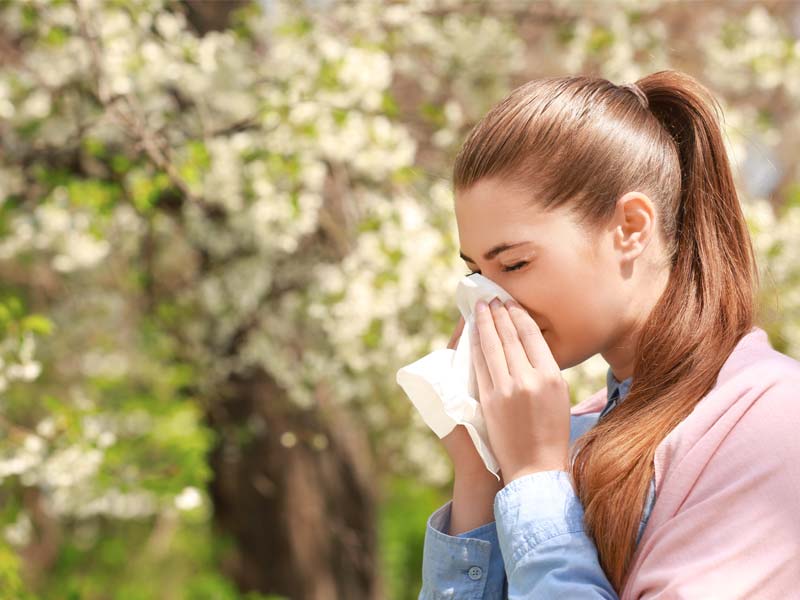With all the snow we’ve had recently, it’s hard to believe it – but spring is finally here. Sunlight and emerging flowers will soon bring a splash of color to your neighborhood, and you will have fewer mornings when you have to leave the house in that thick coat. But for some, spring is spelled A-L-L-E-R-G-I-E-S, which can be a heavy price to pay for all the natural beauty in our state.
If you are one of the many that suffer from these seasonal intruders, you want to do whatever it takes to breathe easier – literally. How can you identify spring allergy symptoms and minimize their effects on your body and overall lifestyle? We’re here to give you some pointers on when it might be time to take action so that you can gain the upper hand on springtime suffering.
Spring Allergy Symptoms Explained
As temperatures rise, a lot of the greenery that has been nurtured by all the rain in our region begins to wake up, releasing its pollen into the air. Pollen can come from not just from flowers, but also from trees and grass.
Your body works hard to protect itself from any intruders and identifies foreign matter like pollen, dander or even mold spores as a threat, which it fights with antibodies. The antibody called Immunoglobulin E (IgE for short) produces histamines that can cause allergic reactions like itchy eyes or a runny nose. Other symptoms can include sinus congestion, post-nasal drip, sneezing, and coughing. For some, an allergic reaction can become severe enough, as in the case of an asthma attack or eyes swelling shut, that their ability to work or even breathe normally is impaired, and immediate medical attention must be sought.
Getting Relief
Allergies are typically at their worst in March through May, but can sometimes start as early as February, as trees can begin to release pollen. Not everyone reacts the same way to allergens or even to the same allergens, so it is a good idea to find out from a doctor which specific ones you react to.
The following are some general guidelines to help you limit your exposure to harmful allergens:
Start Your Spring Cleaning Early
Despite the unpredictability of nature, your home should be a refuge and is one space you can control. You can start by cleaning all the surfaces indoors. Dust your bookcases, clean out light fixtures, vacuum furniture, even wash your curtains and bedspreads. While these may look clean at first glance, they can contain months of pollen buildup from the outdoors.
We mentioned allergic reactions could come not only from pollen that you find outdoors but also from things such as mold. Ensure that moist areas by bathtubs, showers, and sinks (even under sinks) have been thoroughly cleaned. You may want to take the extra step of monitoring humidity levels if you are sensitive to mold, as a humidity level of more than 50% can create an inviting environment for mold to return.
You’ll also want to be aware of allergen-producing plants that are in your yard. If you’re planting or weeding, you can purchase a particulate-filtering mask to protect your lungs. Also, don’t bring what you’re trying to get rid of back inside! Since pollen can stick to your clothing, skin or hair, be sure to clean your clothing and yourself thoroughly when going back indoors.
Keep Your Indoor Air Clean
While you probably aren’t going to live inside a plastic bubble, you can reduce the number of foreign particulates in the air you breathe inside. You can start by keeping the windows shut if you’re suffering from allergies, especially on dry, windy days. The same goes for your car – keep windows up and push your car’s air recirculation button.
If your home has forced air heating or air conditioning, you’ll want to use a high-efficiency HEPA filter. Don’t forget to change it regularly according to its maintenance schedule (usually every three months). Some filters can just be washed instead of replaced. Using a dehumidifier can also keep your indoor air free from unwanted moisture.

Prepare for the Worst
Your local weather report is a great source to find out when pollen levels may be at their highest. During this time, it’s good to keep your doors and windows closed in advance of these events, and avoid outdoor activity in the mornings and early evenings on these days, as that’s when pollen counts are usually the highest.
If you’ve been prescribed allergy medication, it’s best to start taking it in advance of the onset of allergy symptoms. You may start a couple of weeks in advance with over-the-counter medications or even a couple of months, depending on the advice of your doctor, if you’re taking allergy shots.
Over-The-Counter Remedies
Sometimes symptoms are not as severe, and you receive the relief you need through one of many over-the-counter medications. Oral antihistamines, such as Claritin or Zyrtec, can relieve sneezing and itchy eyes. Decongestants like Sudafed or Afrin will give you relief from feeling stuffed up in your nasal passages. Still, other medications, such as Drixoral, combine an antihistamine with a decongestant.
It’s always best to consult with your doctor before treating your allergy symptoms. Some may make you drowsy and should not be used while driving or operating any dangerous equipment. Prolonged use of others can often result in a relapse of symptoms.
Remember – you don’t have to wait until spring allergy symptoms are in full swing to take action. Start preparing now, before they reach their peak levels. Make sure you have cleaned out your home and car, and that you keep the air clean throughout the season. Keep your eyes on the weather and allergen forecasts so you can know when to heighten your defenses.
Also, seek out medical advice in advance as you work to treat any symptoms that may come up. We, at Camas Swale, can equip you with the information you’ll need to ensure a healthier, more comfortable springtime ahead.

